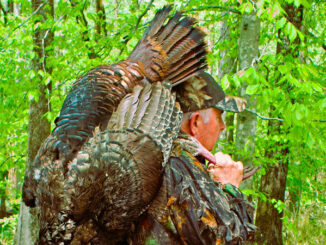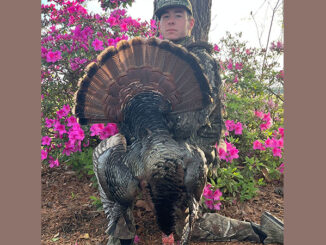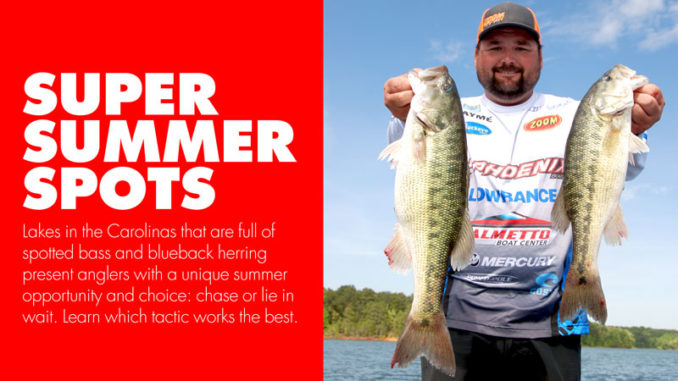
Lakes in the Carolinas that are full of spotted bass and blueback herring present summer anglers with a unique opportunity and choice: chase or lie in wait. Learn which tactic works the best.
How spotted bass came to reside in many reservoirs in the Carolinas is a subject of much debate. They are in several mountain and Piedmont lakes in North Carolina as well as the lakes on or connected to the Savannah River chain in South Carolina.
Native to Illinois, Missouri and Ohio, southward to eastern Texas and the Gulf of Mexico — including most major drainages of the Mississippi River — they have been introduced into many eastern lakes and reservoirs, usually to the detriment of the native black bass species that exist there.
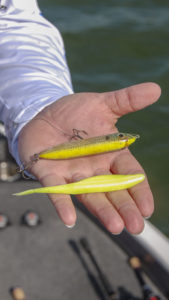
Love them or hate them, spotted bass have become a staple for many bass anglers because of their aggressive nature and willingness to bite once you determine their location.
Few know better than Jayme Rampey of Liberty, S.C., a pro bass angler who hails from the middle of spotted bass territory. He said the lakes that seem to have the best spotted bass fishing have several characteristics in common: deep, clear water with blueback herring as a primary or at least prevalent food source.
Rampey said the trick to catching spotted bass during the summer, when water temperatures climb into the high 80s and above, is to look for them in deep water.
“Spots go deep in hot weather,” he said. “Look for them to be holding on any type of wood structure in 25 to 30 feet of water. You’ll be able to see them holding on the wood on your graph.”
Rampey employs one of three tactics for catching spots in July, and they are related.
The first is a topwater bite, which typically occurs early and late in the day but may also possibly happen in the middle of the day.
“I think these fish have better eyesight than largemouth,” he said. “They might be sitting in 30 feet of water, but they can see that surface commotion, and they’ll come up and check it out.”
Rampey said if the fish are shy about coming all the way to the surface, then he’ll throw a weighted or unweighted Fluke as a subsurface lure. If that doesn’t work, then he will position his boat right over the fish and use a drop-shot rig.
“Spots are not hard to catch,” he said. “Probably the hardest part is finding them, not getting them to bite.”
Rampey recommended fishing depths of 25 to 30 feet. They typically produce even better if there is structure like a long point or hump that has even deeper water close by. This is a classic ambush spot in herring lakes for predator fish to hold while waiting for herring to swim past.
Because Rampey’s tackle choices will vary between topwater, sub-surface, and bottom-fishing gear, he keeps at least three rods rigged to tackle spots in the summer.
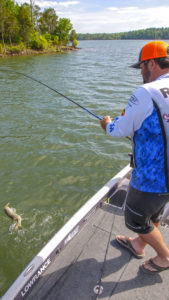
His topwater rod will be a 6- to 7-foot baitcasting outfit spooled with 40-pound braid. He’s not overly concerned with spotted bass seeing the braid, since the majority of the line is out of the water as he’s walking-the-dog with a chrome-colored Zara Spook. The chrome might be changed to a bone or white on a cloudy day, but he sticks with light colors.
For sub-surface baits, he’ll spool a similar 6- to 7-foot baitcasting or spinning rod with 15-pound monofilament and tie on a white or pearl Zoom Fluke. He has found that spotted bass that would hit the topwater bait and then quit, will still eat the Fluke an hour later if it’s fished in a jerky manner just below the surface or if allowed to fall 5 to 6 feet on the retrieve.
The drop-shot rig is the finesse tactic. He spools a 6- to 7-foot, light- to medium-action spinning rod with 6-pound mono. A tungsten drop-shot weight anchors the rig and a drop-shot/mosquito hook is tied in-line 2 feet above the weight.
“I’ll fish the drop-shot right in the wood,” he said. “I think the light line is necessary because you’re putting your bait right on the fish, and they do have pretty good eyesight, especially in clear lakes.”
He rigs the hook with a Zoom Prism Z3 trick worm.
Rampey said spots make up an important component in putting together a winning weight in summer bass tournaments.
“Like I said, they’re so aggressive, they’re easy to catch, so I usually concentrate on putting five decent fish in the boat, all spots, and then start looking for two or three bigger largemouth to draw a check,” he said.
“So a summertime bag will mean I’m weighing either two or three spots mixed with two or three largemouths.”
Blueback Herring: The Deepwater Baitfish
For fishermen who remember the days before blueback herring became established in many reservoirs across the Carolinas, predators like largemouth, striped and later, spotted bass were forced to choose between invading the shallows to feed on threadfin shad, gizzard shad and other shallow-water forage during the summer when water temperatures skyrocketed, or going on diets in the deeper, cooler waters where predators were more comfortable but shad preferred not to visit.
Fast-forward to modern day after the arrival, most likely by illegal stockings, of blueback herring, which became established quickly in deeper, clearer lakes across the Carolinas. Predator fish found a nomadic, deepwater food source that ultimately changed many summer fishing patterns across the board.
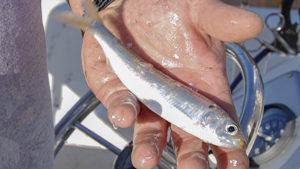
The reason predator fish no longer have to go on a summer diet is because, unlike shad — which prefer shallower water and do not require higher levels of dissolved oxygen — blueback herring have a similar hot-water intolerances. Herring much prefer the deeper and darker waters with adequate dissolved-oxygen levels during the summer.
The end result is “two-story” bait: one that bass can gorge on at deeper levels during the summer, until cooler weather and water prevails and predators can add the remaining shallow-water food sources back to their menus.
Herring lakes throw a lot of bass anglers off their game because herring live a nomadic lifestyle. Cliff Pace, a Mississippi bass pro who has made no bones about his disdain for herring lakes, once made the adept analogy that it’s like moving the refrigerator around in your house.
“One day the refrigerator is in the kitchen; the next day it’s in the living room and then the next day it’s in the guest bedroom closet,” he said.
South Carolina pro Jayme Rampey, who prefers fishing herring lakes, said chasing the baitfish can be frustrating. The key to catching spotted bass, or any predator that regularly preys on herring in the summer, is to understand how the fish relate to the bait.
“A lot of bass anglers who don’t regularly fish herring lakes try to pattern the herring to find the fish,” he said. “That might work to a degree, but your bigger fish are going to lay in wait on some wood on a point or hump and let the herring come to them.”

